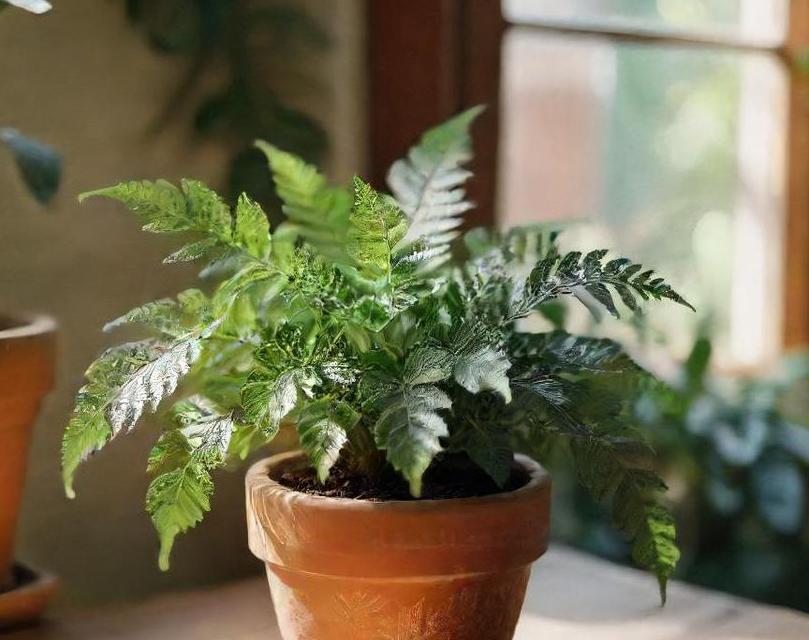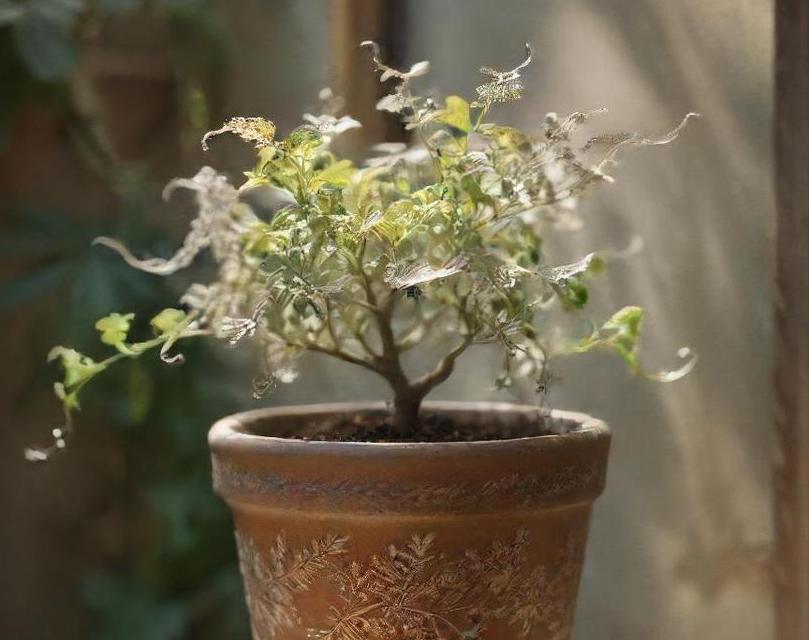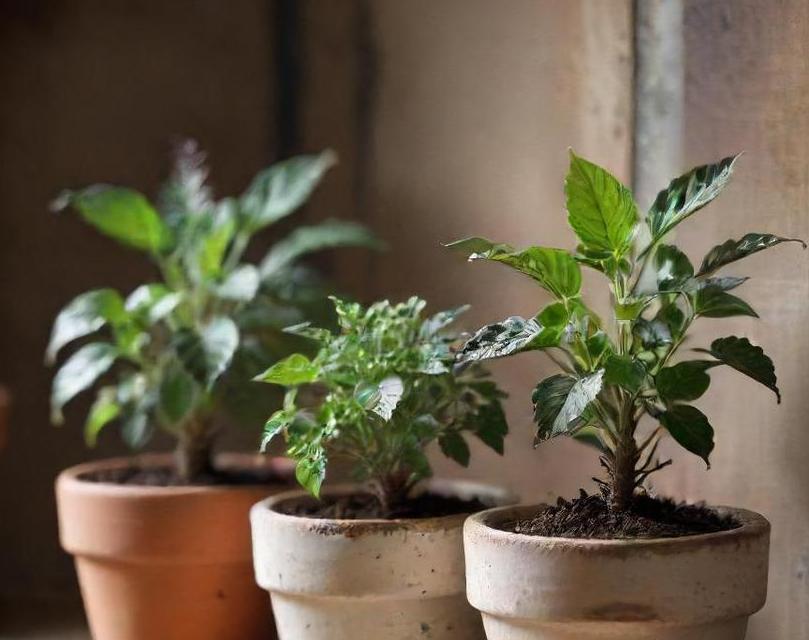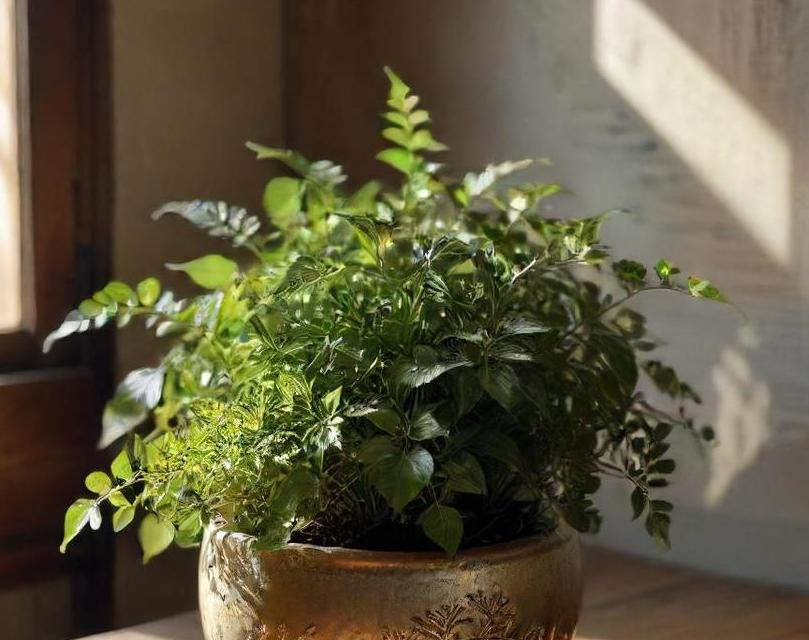- You are here:
- Home »
- Indoor Plants
- » Bolbitis Mini Care Guide

Bolbitis Mini Care Guide
Indoor plants have surged in popularity over the past few decades, not only for their aesthetic appeal but also for their numerous health benefits and their ability to purify indoor air. Among the diverse array of indoor plants, Bolbitis Mini stands out as an intriguing choice for plant enthusiasts and novices alike. With its unique appearance and relatively low maintenance requirements, Bolbitis Mini has earned a special place in the hearts of many indoor gardeners. In this comprehensive guide, we delve into the world of Bolbitis Mini, exploring its botanical characteristics, historical significance, common names, varieties, and more.
Contents
- 1 What Is Bolbitis Mini?
- 2 Botanical Characteristics
- 3 Historical And Cultural Significance
- 4 Common Names And Varieties
- 5 Light Requirements
- 6 Soil Requirements
- 7 Temperature Requirements
- 8 Humidity Requirements
- 9 Watering Needs For Bolbitis Mini
- 10 Fertilization
- 11 How To Plant Bolbitis Mini
- 12 Potting
- 13 Pruning Techniques For Bolbitis Mini
- 14 Propagation Methods For Bolbitis Mini
- 15 Troubleshooting Problems With Planting Bolbitis Mini Indoors
- 16 Conclusion
- 17 FAQS
What Is Bolbitis Mini?
Bolbitis Mini, scientifically known as Bolbitis heteroclita, is a species of fern belonging to the family Dryopteridaceae. It is native to tropical regions of Africa and Asia, where it typically grows in damp, shaded areas such as riverbanks, stream edges, and forest floors. The name "Bolbitis" is derived from the Greek word "bolbos," meaning bulb, referring to the swollen base of the rhizome characteristic of this genus.
Bolbitis Mini is often cultivated as an aquarium plant due to its ability to thrive in submerged conditions, but it also makes an excellent addition to indoor gardens and terrariums. Its compact size and attractive foliage make it a popular choice for creating lush, green displays in confined spaces.
Botanical Characteristics
Morphology
Bolbitis Mini is a small fern with distinctive fronds that grow in a rosette-like arrangement. The fronds are deeply lobed and typically measure between 10 to 20 centimeters in length, though they can grow larger under optimal conditions. The foliage ranges in color from bright green to deep emerald, adding a vibrant touch to any indoor setting.
Rhizome
Like other ferns, Bolbitis Mini spreads via underground rhizomes, which serve as both a means of propagation and a source of nutrients. The rhizome of Bolbitis Mini is relatively thin and wiry, with small roots extending from its nodes to anchor the plant in its substrate.
Reproduction
Bolbitis Mini reproduces via spores, which are produced on the undersides of its fronds in structures known as sporangia. When the spores mature, they are released into the surrounding environment, where they can germinate and develop into new ferns under suitable conditions.
Growth Habit
In its natural habitat, Bolbitis Mini often grows as an epiphyte, clinging to rocks and tree branches along the edges of waterways. In cultivation, it can be grown submerged in water or planted in a well-draining substrate with regular watering to keep the soil consistently moist.
Historical And Cultural Significance

Traditional Uses
Throughout history, ferns have held symbolic significance in various cultures around the world. In some societies, ferns were believed to possess mystical properties and were used in rituals and ceremonies. However, there are no known specific traditional uses of Bolbitis Mini.
Modern Cultivation
The cultivation of Bolbitis Mini as an aquarium plant has become increasingly popular among aquarists in recent years. Its attractive foliage and adaptability to submerged conditions make it an ideal choice for adding visual interest to freshwater aquariums. Additionally, Bolbitis Mini is valued by indoor gardeners for its ability to thrive in low-light conditions, making it well-suited for use in terrariums and shady corners of the home.
Common Names And Varieties
Common Names
Bolbitis Mini is known by various common names, including Mini Bolbitis, African Water Fern, and Mini Water Fern. These names reflect its diminutive size and its preference for moist environments.
Varieties
While Bolbitis Mini is the most commonly cultivated species within its genus, there are several other species of Bolbitis that are also popular among plant enthusiasts. These include Bolbitis heudelotii, Bolbitis difformis, and Bolbitis asiatica, each of which exhibits its own unique characteristics and growth habits.
Bolbitis Mini is a fascinating indoor plant with a rich history and a host of desirable characteristics. From its compact size and attractive foliage to its adaptability to various growing conditions, Bolbitis Mini has much to offer both novice and experienced gardeners alike. Whether used as a focal point in a terrarium or as a graceful accent in an aquarium, Bolbitis Mini is sure to delight with its beauty and versatility. With proper care and attention, this diminutive fern can thrive and bring a touch of greenery to any indoor space.
Light Requirements

Bolbitis Mini, scientifically known as Bolbitis heteroclita ‘Mini’, is a charming fern species native to Southeast Asia. Belonging to the family Lomariopsidaceae, Bolbitis Mini is prized for its striking appearance and relatively undemanding nature, making it a popular choice among indoor gardening enthusiasts.
This fern features delicate, lacy foliage that adds a touch of sophistication to any indoor space. Its compact size makes it ideal for terrariums, vivariums, or as an accent plant in aquariums. With proper care, Bolbitis Mini can thrive indoors, bringing a touch of lush greenery to homes, offices, or any interior setting.
Bolbitis Mini thrives in moderate to low light conditions, making it well-suited for indoor environments where direct sunlight may be limited. Ideally, it should be placed in a location with indirect sunlight or filtered light. Direct sunlight can scorch its delicate foliage, leading to leaf burn and decline in health.
A north-facing window or a spot several feet away from an east or west-facing window provides the optimal lighting conditions for Bolbitis Mini. If natural light is insufficient, supplemental artificial lighting from fluorescent or LED grow lights can be used to provide adequate illumination.
It’s essential to monitor the plant’s response to light and adjust its placement accordingly. Signs of inadequate light include pale or yellowing foliage, stunted growth, and leggy stems. On the other hand, excessive light can result in sunburned leaves and leaf discoloration.
Soil Requirements
The soil requirements of Bolbitis Mini are relatively simple, as long as certain key factors are considered. This fern thrives in well-draining, nutrient-rich substrate that retains moisture without becoming waterlogged. A mixture of peat moss, perlite, and fine-grade orchid bark provides an ideal growing medium for Bolbitis Mini.
The soil pH should be slightly acidic to neutral, ranging between 5.5 to 7.0, to support optimal nutrient uptake and root health. Regular potting soil or a specialized fern potting mix can be amended with additional organic matter to enhance moisture retention and fertility.
When planting Bolbitis Mini, ensure that the rhizome, the thickened stem from which the roots and fronds emerge, is partially buried in the soil while allowing the fronds to extend above the surface. This helps anchor the plant securely and promotes healthy growth.
Temperature Requirements

Maintaining the appropriate temperature is crucial for the well-being of Bolbitis Mini. This fern species thrives in a relatively warm and stable environment, mimicking its natural habitat in tropical regions.
The ideal temperature range for Bolbitis Mini falls between 18 to 26 degrees Celsius (65 to 80 degrees Fahrenheit). Temperatures outside this range can adversely affect the plant’s growth and vitality.
Avoid exposing Bolbitis Mini to sudden temperature fluctuations or drafts, as they can stress the plant and make it more susceptible to pests and diseases. Positioning the plant away from heating or cooling vents and ensuring consistent room temperatures contribute to its overall health and vigor.
Humidity Requirements
As a tropical plant, Bolbitis Mini thrives in high humidity environments reminiscent of its native habitat. Adequate humidity levels are essential for maintaining healthy foliage and preventing desiccation.
The ideal humidity range for Bolbitis Mini falls between 50% to 70%. In indoor settings where humidity levels may be lower, especially during the winter months or in air-conditioned spaces, supplemental humidity may be necessary to create a favorable microclimate for the plant.
Several methods can be employed to increase humidity around Bolbitis Mini. Placing the plant on a humidity tray filled with water and pebbles helps create a humid microenvironment around the plant through evaporation. Misting the foliage regularly with water can also help boost humidity levels.
Additionally, grouping indoor plants together or using a room humidifier can raise ambient humidity levels, benefiting not only Bolbitis Mini but other moisture-loving plants as well.
Bolbitis Mini is a captivating indoor plant that adds beauty and elegance to any interior space. With its delicate foliage and relatively undemanding nature, it is well-suited for both novice and experienced indoor gardeners. Providing the right growing conditions is essential for the health and vitality of Bolbitis Mini. This includes providing moderate to low light, well-draining soil with adequate moisture retention, maintaining stable temperatures between 18 to 26 degrees Celsius, and ensuring high humidity levels between 50% to 70%. By understanding and meeting these requirements, indoor gardening enthusiasts can enjoy the beauty of Bolbitis Mini and create lush, verdant displays that enhance the ambiance of their homes, offices, or indoor landscapes. With proper care and attention, Bolbitis Mini will thrive and delight with its graceful foliage and timeless charm.
Watering Needs For Bolbitis Mini

Bolbitis Mini, also known as African water fern or simply mini Bolbitis, is a species of fern native to Africa, particularly found in regions with high humidity and ample shade, such as tropical rainforests. It belongs to the family of ferns known as Lomariopsidaceae. Bolbitis Mini is characterized by its delicate, intricate leaves that grow in a rosette-like pattern, creating a beautiful and captivating display when grown submerged in water.
Unlike some other fern species, Bolbitis Mini is well-suited for aquatic environments, making it an excellent choice for aquariums or terrariums. Its ability to thrive both submerged and emersed makes it a versatile plant that can be used in various aquascape setups, from lush underwater landscapes to semi-aquatic environments.
Proper watering is essential for the health and vitality of Bolbitis Mini. As a semi-aquatic plant, it requires consistent moisture to thrive, whether grown submerged in water or planted in a moist substrate. When grown in an aquarium or terrarium, Bolbitis Mini should be placed in an environment with clean, filtered water and a stable temperature.
In aquariums, Bolbitis Mini can be planted directly into the substrate or attached to driftwood or rocks using fishing line or specialized plant glue. It is important to ensure that the plant’s rhizome, the thick stem from which the leaves grow, is not buried in the substrate, as this can lead to rot. Instead, the rhizome should be left exposed or partially buried to allow for proper nutrient uptake.
Maintaining adequate water quality is crucial for the health of Bolbitis Mini. Regular water changes, filtration, and monitoring of water parameters such as pH, hardness, and ammonia levels are essential for creating a suitable environment for this plant to thrive.
Fertilization
While Bolbitis Mini is not a heavy feeder compared to some other aquatic plants, it can benefit from occasional fertilization to promote healthy growth and vibrant foliage. In aquariums, liquid fertilizers or root tabs can be used to provide essential nutrients such as nitrogen, phosphorus, and potassium.
When fertilizing Bolbitis Mini, it is important to follow the recommended dosage instructions carefully to avoid over-fertilization, which can lead to algae problems and other issues. Additionally, regular water changes can help prevent the buildup of excess nutrients in the aquarium water, ensuring a balanced and healthy ecosystem for both the plant and aquatic inhabitants.
How To Plant Bolbitis Mini

Planting Bolbitis Mini can be done in various ways, depending on the desired setup and aesthetic preferences. Whether grown submerged in water or planted in a terrarium, proper planting techniques are essential for ensuring the plant’s health and vitality.
Submerged Planting
When planting Bolbitis Mini in an aquarium, there are several methods to consider:
-
Direct Planting: Bolbitis Mini can be planted directly into the substrate, taking care not to bury the rhizome. The roots should be gently pressed into the substrate to secure the plant in place.
-
Attachment to Hardscape: Alternatively, Bolbitis Mini can be attached to driftwood, rocks, or other hardscape elements using fishing line or plant glue. This method allows for more flexibility in positioning and can create visually striking aquascape layouts.
-
Floating Placement: In some cases, Bolbitis Mini can be left floating on the water’s surface, especially during the acclimation period or when transitioning to a new environment. Once the plant has established roots, it can be anchored to the substrate or hardscape as desired.
Emersed Planting
In terrariums or paludariums, Bolbitis Mini can be planted in a moist substrate with high humidity levels. The planting process is similar to that of submerged planting, with the main difference being the absence of standing water.
-
Substrate Selection: Choose a well-draining substrate such as a mixture of potting soil and peat moss or a specialized terrarium substrate designed for tropical plants.
-
Planting Depth: Plant Bolbitis Mini at the appropriate depth, ensuring that the rhizome is positioned above the substrate surface to prevent rot.
-
Humidity and Ventilation: Maintain high humidity levels within the terrarium by misting the plants regularly and providing adequate ventilation to prevent mold and fungal growth.
Potting
Potting Bolbitis Mini in containers or pots is another option for growing this versatile plant indoors. Whether planted in soil or a soilless growing medium, proper potting techniques are essential for providing adequate support and nutrition to the plant.
-
Container Selection: Choose a container with drainage holes at the bottom to prevent waterlogged soil, which can lead to root rot. Select a container that is appropriately sized for the plant, allowing room for root growth.
-
Soil Preparation: Prepare a well-draining potting mix using a combination of peat moss, perlite, and coarse sand. This will provide good aeration and drainage while retaining moisture.
-
Planting Depth: Plant Bolbitis Mini at the same depth it was previously growing, ensuring that the rhizome is positioned slightly above the soil surface.
-
Watering: Water the plant thoroughly after potting to settle the soil and provide initial hydration. Allow excess water to drain from the bottom of the container, and avoid overwatering to prevent waterlogged soil.
-
Lighting and Maintenance: Place the potted Bolbitis Mini in a location with bright, indirect light and maintain consistent moisture levels by watering when the top inch of soil feels dry. Prune any yellowing or dead leaves as needed to promote healthy growth.
Bolbitis Mini is a captivating and versatile indoor plant that can thrive in a variety of environments, from aquariums and terrariums to pots and containers. With its unique appearance and relatively low maintenance requirements, Bolbitis Mini has become a popular choice among plant enthusiasts looking to add a touch of greenery to their indoor spaces. By understanding and meeting the plant's specific needs for watering, fertilization, and planting, enthusiasts can enjoy the beauty and benefits of Bolbitis Mini in their homes or offices. Whether grown submerged in water, planted in a terrarium, or potted in soil, Bolbitis Mini adds a touch of elegance and natural beauty to any indoor environment. With proper care and attention, this charming fern will continue to thrive and delight for years to come.
Pruning Techniques For Bolbitis Mini
Bolbitis Mini, also known as Bolbitis heteroclita ‘Mini’, is a popular choice among indoor plant enthusiasts due to its unique appearance and relatively low maintenance requirements. This small fern species belongs to the family of Bolbitidaceae and is native to Africa and Southeast Asia, where it typically grows in humid, shaded areas along streams and rivers.
The Bolbitis Mini features delicate, intricate leaves that add a touch of elegance to any indoor space. Its dark green fronds are deeply lobed and have a slightly transparent quality, giving them a distinctively beautiful aesthetic. This plant is well-suited for terrariums, aquariums, or as a standalone specimen in a small pot.
Pruning is an essential aspect of caring for Bolbitis Mini, as it helps maintain the plant’s health and appearance. Here are some pruning techniques to keep your Bolbitis Mini thriving:
1. Removal Of Dead Or Yellowing Leaves
Regularly inspect your Bolbitis Mini for any dead or yellowing leaves, as these can detract from the plant’s overall appearance and may indicate underlying issues such as overwatering or inadequate light. Use sterilized scissors or pruning shears to carefully trim away any unhealthy foliage, making clean cuts near the base of the stem.
2. Trimming Overgrown Fronds
Bolbitis Mini has a tendency to produce long, trailing fronds that can become tangled or overcrowded over time. To maintain a tidy appearance and encourage healthy growth, trim back any overgrown fronds using sharp scissors or pruning shears. Aim to cut the fronds to a length that complements the overall shape of the plant while leaving enough foliage to support photosynthesis.
3. Pruning Rhizomes
Bolbitis Mini spreads via creeping rhizomes, which can become overcrowded if left unchecked. To prevent the rhizomes from overtaking the container or aquarium, periodically prune them back using sharp scissors or a clean knife. Be sure to remove any dead or decaying portions of the rhizomes to prevent them from rotting and potentially harming the plant.
Propagation Methods For Bolbitis Mini
Propagating Bolbitis Mini is relatively straightforward and can be accomplished through division or spore propagation. Here’s how to propagate this plant effectively:
1. Division
Division is the simplest method of propagating Bolbitis Mini and involves separating the plant into smaller sections, each with its own rhizome and fronds. To divide the plant, carefully remove it from its container and gently tease apart the rhizomes using your fingers or a clean knife. Ensure that each divided section has a healthy portion of rhizome and several fronds attached. Plant the divisions in separate containers filled with moist, well-draining potting mix, and place them in a location with indirect light and high humidity.
2. Spore Propagation
Spore propagation is another option for propagating Bolbitis Mini, although it requires a bit more patience and attention to detail. To collect spores, wait until the plant produces mature sporangia, which are small structures located on the underside of the fronds. Carefully remove a frond containing sporangia and place it in a paper bag to allow the spores to dry and release. Once the sporangia have released their spores, carefully sprinkle them onto a moist substrate, such as peat moss or coconut coir. Keep the substrate consistently moist and maintain high humidity levels to encourage spore germination and the development of new ferns.
Troubleshooting Problems With Planting Bolbitis Mini Indoors
While Bolbitis Mini is relatively resilient, it can still encounter issues when grown indoors. Here are some common problems and troubleshooting tips to help keep your plant healthy:
1. Yellowing Or Browning Fronds
Yellowing or browning fronds are often a sign of inadequate light or overwatering. If your Bolbitis Mini is experiencing this issue, try moving it to a location with brighter, indirect light and adjusting your watering routine to ensure that the soil remains evenly moist but not waterlogged. Trim away any dead or discolored foliage to promote new growth.
2. Fungal Diseases
Bolbitis Mini is susceptible to fungal diseases such as root rot if its growing conditions are too damp or humid. To prevent fungal issues, ensure that the plant’s container has proper drainage and avoid overwatering. If you suspect fungal infection, remove the affected portions of the plant and treat the remaining foliage with a fungicide according to the manufacturer’s instructions.
3. Pest Infestations
Like many indoor plants, Bolbitis Mini can attract pests such as aphids, mealybugs, and scale insects. If you notice signs of pest infestation, such as visible insects or sticky residue on the leaves, take immediate action to control the problem. Depending on the severity of the infestation, you may need to manually remove the pests, use insecticidal soap, or introduce natural predators such as ladybugs to help eliminate the pests.
4. Nutrient Deficiencies
If your Bolbitis Mini exhibits stunted growth or yellowing foliage, it may be suffering from nutrient deficiencies. To address this issue, consider fertilizing the plant with a balanced, water-soluble fertilizer formulated for ferns. Follow the fertilizer manufacturer’s recommendations for application frequency and dosage, being careful not to over-fertilize, which can lead to fertilizer burn.
Conclusion
Bolbitis Mini is a stunning indoor plant that adds a touch of natural beauty to any indoor space. With its delicate fronds and relatively low maintenance requirements, it’s an excellent choice for both novice and experienced plant enthusiasts alike. By following the pruning techniques, propagation methods, and troubleshooting tips outlined in this guide, you can ensure that your Bolbitis Mini thrives and flourishes for years to come. Whether displayed in a terrarium, aquarium, or as a standalone specimen, this charming fern is sure to captivate admirers with its unique charm and elegance.
FAQS
What Is Bolbitis Mini?
Bolbitis Mini, scientifically known as Bolbitis heteroclita ‘Mini’, is a species of fern that belongs to the family Lomariopsidaceae. It is a miniature variant of the Bolbitis genus, prized for its compact size and elegant appearance, making it a popular choice for indoor plant enthusiasts.
How Big Does Bolbitis Mini Grow?
Bolbitis Mini typically grows to a height of around 6 to 8 inches (15 to 20 centimeters) and spreads outwards to form a dense cluster of fronds. Its compact size makes it suitable for small to medium-sized aquariums or terrariums, as well as for planting in pots or containers for indoor decoration.
What Are The Care Requirements For Bolbitis Mini?
Bolbitis Mini thrives in humid and shaded environments, mimicking its natural habitat in tropical regions. It prefers indirect light and should be protected from direct sunlight, which can scorch its delicate fronds. Keep the soil or substrate consistently moist but not waterlogged, and provide good drainage to prevent root rot.
Can Bolbitis Mini Be Grown In Water?
Yes, Bolbitis Mini can be grown in water, making it suitable for aquariums or paludariums. It can be attached to driftwood, rocks, or other surfaces using fishing line or plant glue until its rhizomes establish a firm grip. Regular water changes are necessary to maintain water quality and prevent algae growth.
How Do You Propagate Bolbitis Mini?
Bolbitis Mini can be propagated through division or by spores. To propagate through division, carefully separate the rhizomes and roots, ensuring that each division has several healthy fronds attached. Plant the divisions in a suitable substrate and provide appropriate care until they establish themselves. Alternatively, you can collect spores from mature fronds and sow them on a moist substrate to grow new plants.
What Are Common Pests And Diseases That Affect Bolbitis Mini?
Bolbitis Mini is generally resistant to pests and diseases, especially when grown in suitable conditions. However, it may occasionally suffer from issues such as scale insects, mealybugs, or fungal infections if environmental conditions are not optimal. Inspect the plant regularly for signs of pests or diseases and treat them promptly with appropriate methods, such as insecticidal soap or fungicides.
How Can I Incorporate Bolbitis Mini Into My Indoor Décor?
Bolbitis Mini’s compact size and attractive foliage make it a versatile plant for indoor decoration. It can be displayed in various ways, such as planted in pots or containers on shelves, desks, or windowsills, or used as a centerpiece in terrariums or vivariums. Its lush green fronds add a touch of natural beauty to any indoor space and can complement a wide range of interior design styles.
